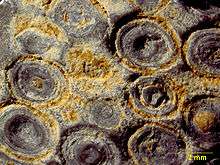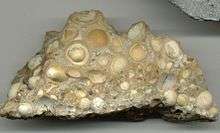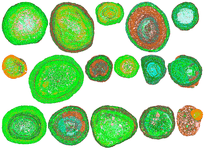Pisolite

Pisoids in the Conococheague limestone (Upper Cambrian) of eastern Pennsylvania

Pisolitic limestone; Itaboraí, Rio de Janeiro, Brazil; pisolith diameters average 1.0 cm

QEMSCAN mineral map of pisoids
A pisolite is a sedimentary rock made of pisoids, which are concretionary grains – often of calcium carbonate, but sometimes of rarer minerals – which resemble ooids but are always more than 2 mm in diameter. These grains are approximately spherical and have concentric layers reaching 10 mm in diameter.
The name derives from the Hellenic word for pea. Bauxites, limonites and siderites often have a pisolitic structure.
References
External links
Mindat. Includes image.
This article is issued from Wikipedia - version of the 9/17/2016. The text is available under the Creative Commons Attribution/Share Alike but additional terms may apply for the media files.